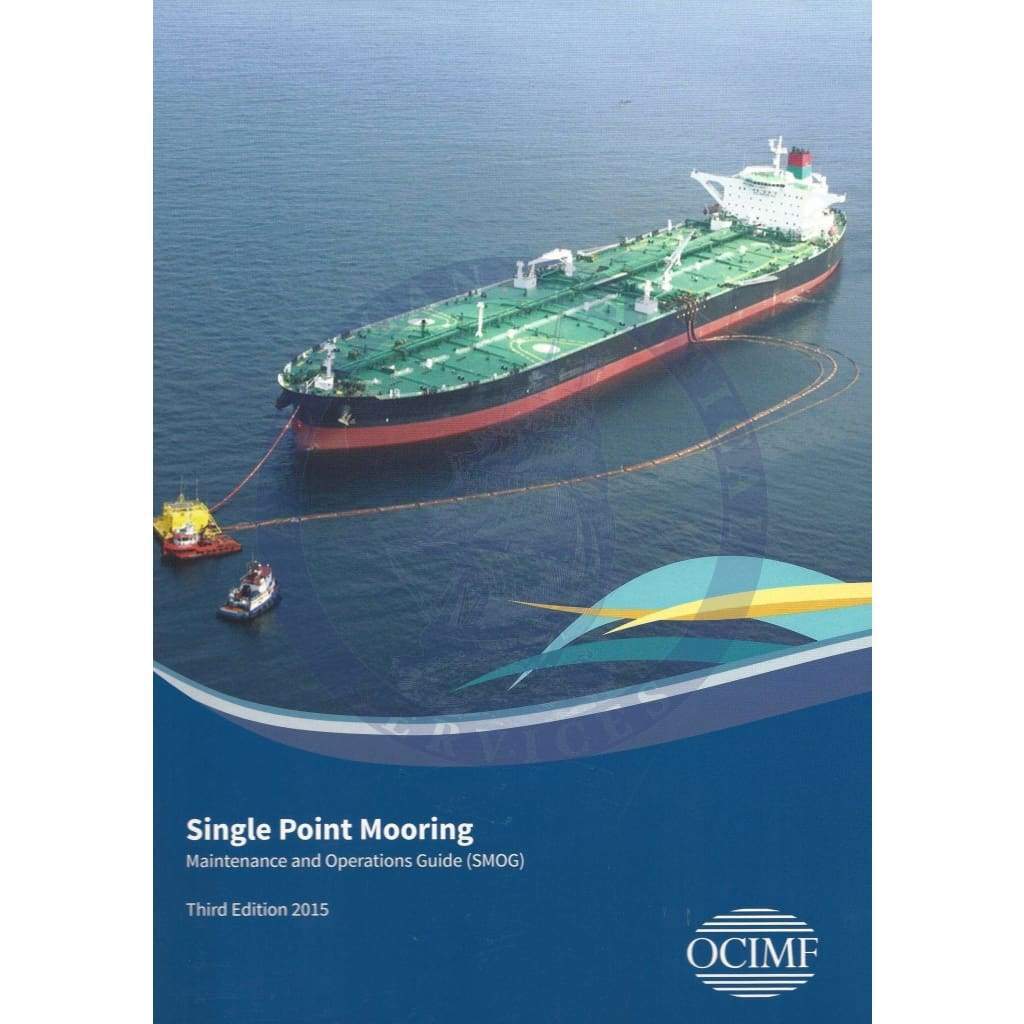style="margin-top: 0pt; margin-bottom: 0pt;"
Overview
SMOG is an industry guide with technical recommendations and guidance for the operation and maintenance of single point moorings (SPM). The guide builds on previous recommendations and the new or significantly changed topics that are included in this edition include:
-
Design of SPM systems.
-
Operation of SPM’s including:
-
Operating environmental limits.
-
Guidance to ensure hoses are lifted safely within tanker crane capacity.
-
Guidance and actions regarding ship/shore cargo quantity comparison.
-
Qualification and training of personnel including Mooring Master skills and competence.
-
Water flushing at SPM’s.
-
The use of hoses, including:
-
Storage, handling and hose string assembly.
-
Hose time in service data from terminals.
-
Specific guidance following overpressure.
-
Hose inspection and testing.
-
Information regarding marine breakaway couplings.
-
Support vessels and the use of tugs.
-
Specific SPM Health, Safety, Security and the Environment (HSSE) guidance.
Content
Contents
Introduction
Abbreviations
Glossary
Bibliography
Section one
Description of single point moorings
1.1 Catenary anchor leg mooring buoys
1.1.1 Turntable buoy
1.1.2 Turret buoy
1.2 Single anchor leg mooring buoy
Section two
Design of single point moorings
2.1 General design considerations
2.1.1 Conceptual risk assessment of proposed terminal
2.1.2 Establishing design considerations
2.1.3 Products to be handled
2.1.4 Tankers and system capacities
2.1.5 Operation and maintenance philosophies
2.1.6 Environmental design conditions
2.1.7 Hydrographic, geotechnical and geophysical surveys
2.2 Site selection and layout
2.2.1 General
2.2.2 Provision of an adequate manoeuvring area
2.2.3 Provision of adequate water depth
2.3 Mooring load transfer system and load analysis
2.3.1 Mooring load transfer system
2.3.2 Environmental factors and abnormal loads
2.4 Petroleum cargo transfer system
2.4.1 Process flow scheme
2.4.2 Cargo transfer system and surge analysis
2.5 Single point mooring buoy design
2.5.1 Design and construction codes and standards
2.5.2 Hazardous area classification for flammable gases and vapours
2.5.3 Power, control and monitoring philosophies
2.5.4 Corrosion protection
2.6 Hose system design
2.6.1 Catenary anchor leg mooring floating hose string
2.6.2 Electrically discontinuous hoses
2.7 Pipeline end manifold
Section three
Operation of single point moorings
3.1 Management of safety, occupational health and security
3.1.1 Hazard and operability analysis
3.2 Pre-arrival procedures
3.2.1 Nomination and tanker acceptance criteria
3.2.2 Pre-arrival exchange of information
3.2.3 Pre-arrival inspection of single point moorings
3.2.4 Pre-berthing exchange of information
3.3 Environmental operating limits
3.4 Personnel and equipment transfer between support vessel and tanker
3.5 Tanker berthing and mooring
3.5.1 Role of Mooring Master (1) – pilotage
3.5.2 Role of Mooring Master (2) – mooring on forecastle
3.6 Connecting rail hoses
3.6.1 Lifting rail hoses
3.6.2 Procedure for connecting rail hoses
3.7 Operations of tankers in berths
3.7.1 Responsibilities
3.7.2 Management of moorings and cargo hoses
3.7.3 Operational communications
3.8 Cargo transfer
3.8.1 Emergency shutdown
3.8.2 Surge pressures
3.9 Disconnecting hoses
3.10 Departure from the single point mooring
3.10.1 Role of Mooring Master (1) – pilotage
3.10.2 Role of Mooring Master (2) – unmooring on forecastle
3.11 Qualifications and training
3.11.1 Competence and training of personnel
3.11.2 Competence of Mooring Masters
Section four
Inspection and maintenance of single point moorings
4.1 Inspection and maintenance principles
4.1.1 Guidance on designing an inspection and maintenance plan
4.2 General precautions
4.3 Inspection and maintenance schedules
4.3.1 Pre-berthing inspection
4.3.2 Buoy and structure inspection
4.3.3 Lubrication
4.3.4 Mooring legs and anchor point inspection
4.3.5 Cargo transfer system inspection
4.3.6 Pipeline end manifold inspection
4.3.7 Electrical, instrument and safety inspection
4.3.8 Post tanker departure inspection
4.4 Mooring system
4.4.1 Mooring hawser
4.4.2 Chafe chain
4.4.3 Pick-up rope
4.4.4 Support buoy
4.4.5 Single point mooring bridle/joint
4.5 Lifting equipment
4.6 Spares policy
4.6.1 Consumables
4.7 Line flushing operations
4.7.1 Flushing
4.7.2 Ensuring an effective flush
4.7.3 Flushing from support vessels
Section five
Handling, storage, testing and inspection of hoses at single point moorings
5.1 Hose lifting and storage
5.1.1 Hose lifting
5.1.2 Hose storage
5.2 Hose string assembly and handling
5.2.1 Hose flange bolting
5.2.2 Handling hose strings
5.3 Hose service life
5.3.1 Demonstrating the integrity of hose systems
5.3.2 Determining hose service life
5.4 Guidance following overpressure and accidents
5.4.1 Overpressure
5.4.2 Vacuum
5.4.3 Loads from breakout or mishandling
5.5 Hose inspection and testing requirements
5.6 Inspection and testing of hose strings in-situ
5.6.1 Inspection of floating hoses
5.6.2 Inspection of submarine hoses
5.6.3 Hydrostatic pressure testing of hose strings in-situ
5.7 Testing hoses on shore
5.7.1 Thorough visual inspection
5.7.2 Hydrostatic pressure test
5.7.3 Vacuum test
5.7.4 Electrical test
5.7.5 Minimum bend radius test (optional)
5.7.6 Weight test (optional)
5.8 Destructive testing of hoses after retirement
5.8.1 Burst tests
5.8.2 Material tests
5.8.3 Hose dissection
5.9 Hose ancillary equipment
5.9.1 Marine breakaway couplings
5.9.2 Rail hose ancillary equipment
5.9.3 Miscellaneous hose ancillary equipment
Appendices
Appendix A: The Elements of MTMSA Applied to SPM Management
Appendix B: Calculating the hose lift weigh
Appendix C: Forecastle watchman guide
Appendix D: Support facilities for single point mooring
D1 Maintenance support vessels
D1.1 Mooring launches
D1.2 Multipurpose support and maintenance vessels
D2 Use of tugs in operational support
D2.1 Use of tugs for mooring and unmooring
D3 Diving services
D3.1 Terminal organisation and responsibilities for diving
Details
Title: Single Point Mooring Maintenance and Operations Guide, 3rd Edition (SMOG) (eBook)
Number of Volumes: 1
Edition: Third
Number of Pages: 104
Product Code: WS1441EA
ISBN: ISBN 13: 978-1-85609-631-7 (9781856096317), ISBN 10: 1-85609-631-9 (1856096319)
Published Date: October 2015
Author: Oil Companies International Marine Forum








